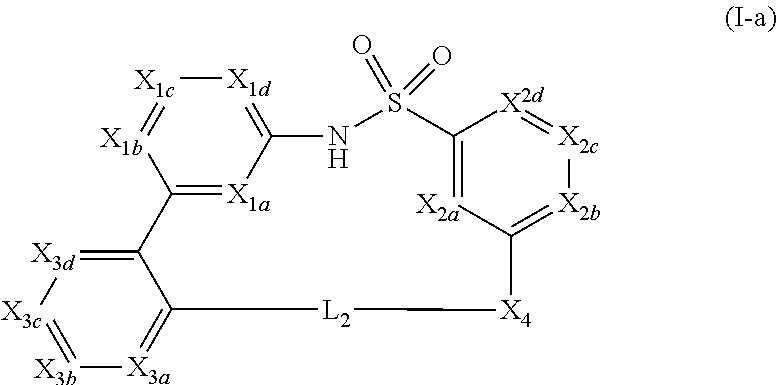Macrocyclic compounds and their use in the treatment of disease
a technology of macrocyclic compounds and their use in the treatment of diseases, applied in the field of macrocyclic compounds, can solve problems such as no cure, and achieve the effects of treating, preventing, or ameliorating cyctic fibrosis
- Summary
- Abstract
- Description
- Claims
- Application Information
AI Technical Summary
Benefits of technology
Problems solved by technology
Method used
Image
Examples
example 57
of 6-(3-hydroxypropyl)-4-thia-3,6-diaza-2,5(2,6)-dipyridina-1(1,2)-benzenacycloundecaphane 4,4-dioxide (57)
[0834]
[0835]6-(3-hydroxypropyl)-4-thia-3,6-diaza-2,5(2,6)-dipyridina-1(1,2)-benzenacycloundecaphane 4,4-dioxide (57) was synthesized using the procedure described in Example 12 except 6-fluoro-N-(5-(trifluoromethyl)-6-(2-vinylphenyl)pyridin-2-yl)pyridine-2-sulfonamide (int-b2) was replaced with 6-fluoro-N-(6-(2-vinylphenyl)pyridin-2-yl)pyridine-2-sulfonamide (int-b6) and 5-(hex-5-en-1-ylamino)pentan-1-ol (int-a34) was replaced with 3-(pent-4-en-1-ylamino)propan-1-ol (int-a24). LCMS (Condition 1): m / z 453.1 [M+H]+. 1.66 min.
Example 58: Synthesis of 6-((1-(hydroxymethyl)cyclopropyl)methyl)-23-(trifluoromethyl)-4-thia-3,6-diaza-2.5(2.6)-dipyridina-1(1.2)-benzenacycloundecaphane 4,4-dioxide (58)
[0836]
[0837]6-((1-(hydroxymethyl)cyclopropyl)methyl)-23-(trifluoromethyl)-4-thia-3,6-diaza-2,5(2,6)-dipyridina-1(1,2)-benzenacycloundecaphane 4,4-dioxide (58) was synthesized using the proce...
example 93
of 3-(4,4-dioxido-4-thia-3,6-diaza-2,5(2,6)-dipyridina-1(1,2)-benzenacycloundecaphane-6-yl)propanoic acid (93)
[0911]
[0912]3-(4,4-dioxido-4-thia-3,6-diaza-2,5(2,6)-dipyridina-1(1,2)-benzenacycloundecaphane-6-yl)propanoic acid (93) was synthesized using the procedure described in Example 62 except 6-(3-hydroxypropyl)-23-(trifluoromethyl)-4-thia-3,6-diaza-2,5(2,6)-dipyridina-1(1,2)-benzenacyclotridecaphane 4,4-dioxide (39) was replaced with 6-(3-hydroxypropyl)-4-thia-3,6-diaza-2,5(2,6)-dipyridina-1(1,2)-benzenacycloundecaphane 4,4-dioxide (57). LCMS (Condition 1): m / z 467.1 [M+H]+, 1.42 min, 1H NMR (400 MHz, Methanol-d4) δ 7.73-7.61 (m, 2H), 7.38-7.31 (m, 1H), 7.31-7.23 (m, 4H), 7.19 (dd, J=8.5, 0.8 Hz, 1H), 6.92 (d, J=7.4 Hz, 1H), 6.81 (d, J=8.7 Hz, 1H), 3.62-3.56 (m, 2H), 3.44 (t, J=7.2 Hz, 2H), 2.67 (dd, J=8.6, 6.7 Hz, 2H), 2.48-2.42 (m, 2H), 1.48 (dd, J=8.6, 6.5 Hz, 2H), 1.33 (d, J=7.2 Hz, 2H), 1.18-1.14 (m, 2H).
Example 94: Synthesis of 1-((4,4-dioxido-23-(trifluoromethyl)-4-thia-3...
PUM
| Property | Measurement | Unit |
|---|---|---|
| enantiomeric excess | aaaaa | aaaaa |
| enantiomeric excess | aaaaa | aaaaa |
| enantiomeric excess | aaaaa | aaaaa |
Abstract
Description
Claims
Application Information
 Login to View More
Login to View More - R&D
- Intellectual Property
- Life Sciences
- Materials
- Tech Scout
- Unparalleled Data Quality
- Higher Quality Content
- 60% Fewer Hallucinations
Browse by: Latest US Patents, China's latest patents, Technical Efficacy Thesaurus, Application Domain, Technology Topic, Popular Technical Reports.
© 2025 PatSnap. All rights reserved.Legal|Privacy policy|Modern Slavery Act Transparency Statement|Sitemap|About US| Contact US: help@patsnap.com



